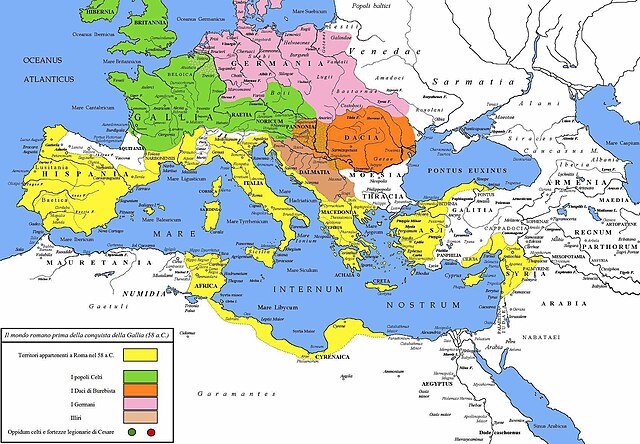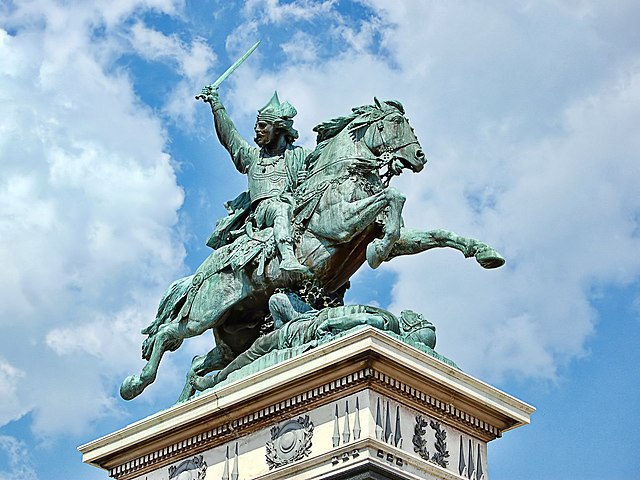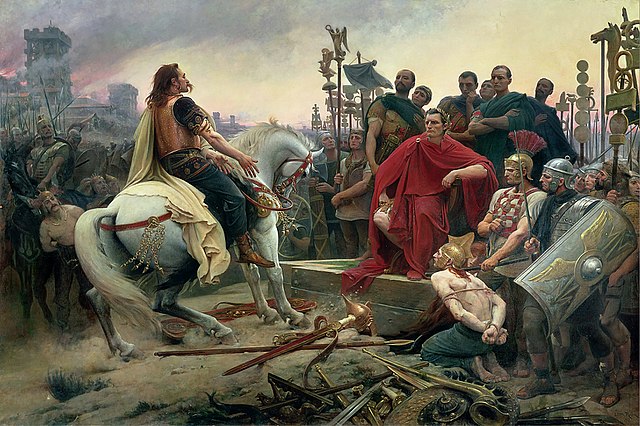Vercingetorix
1st-century BC Gallic chieftain From Wikipedia, the free encyclopedia
Vercingetorix (Latin: [wɛrkɪŋˈɡɛtɔriːks]; Ancient Greek: Οὐερκιγγετόριξ [u.erkiŋɡeˈtoriks]; c. 80 – 46 BC) was a Gallic king and chieftain of the Arverni tribe who united the Gauls in a failed revolt against Roman forces during the last phase of Julius Caesar's Gallic Wars. After surrendering to Caesar and spending almost six years in prison, he was executed in Rome.
This article has multiple issues. Please help improve it or discuss these issues on the talk page. (Learn how and when to remove these messages)
|
Vercingetorix | |
|---|---|
 | |
| King of the Arverni | |
| Personal details | |
| Born | c. 80 BC[2] Unknown |
| Died | 46 BC (aged 36–37) Rome, Italy, Roman Republic |
| Cause of death | Execution by strangling |
Vercingetorix was the son of Celtillus the Arvernian, leader of the Gallic tribes. Vercingetorix came to power after his formal designation as chieftain of the Arverni at the oppidum Gergovia in 52 BC. He immediately established an alliance with other Gallic tribes, took command, combined all forces and led them in the Celts' most significant revolt against Roman power. He won the Battle of Gergovia against Julius Caesar in which several thousand Romans and their allies were killed and the Roman legions withdrew.
Caesar had been able to exploit Gaulish internal divisions to easily subjugate the country, since Vercingetorix's attempt to unite the Gauls against Roman invasion came too late.[3][4] At the Battle of Alesia, also in 52 BC, the Romans besieged and defeated his forces. To spare as many of his men as possible, he gave himself to the Romans. He was held prisoner for five years. In 46 BC, as part of Caesar's triumph, he was paraded through the streets of Rome and then executed by garroting. Vercingetorix is primarily known through Caesar's Commentarii de Bello Gallico (Commentaries on the Gallic War). He is considered a folk hero in France, and especially in Auvergne, his native region.

Name
The Gaulish name Vercingetorix can be literally translated as 'great king' or 'leader of warriors', from ver- ('over', 'superior') + -cingeto- ('warrior, hero') + -rix ('king').[5][6][7] Scholar Maigréad Ní C. Dobbs has proposed to see an Irish cognate of the name in the form Ferchinged an rí.[8] In his Life of Caesar, Plutarch renders the name as Vergentorix (Οὐεργεντόριξ).[9] According to Florus, he was "endowed [...] with a name which seemed to be intended to inspire terror".[10]
Background
Summarize
Perspective


Having been appointed governor of the Roman province of Gallia Narbonensis (modern Provence) in 58 BC, Julius Caesar proceeded to conquer the Gallic tribes beyond over the next few years, maintaining control through a careful divide and rule strategy. He made use of the factionalism among the Gallic elites, favouring certain noblemen over others with political support and Roman luxuries such as wine. Attempts at revolt, such as that of Ambiorix in 54 BC, had secured only local support, but Vercingetorix, whose father, Celtillus, had been put to death by his own countrymen for seeking to rule all of Gaul, managed to unify the Gallic tribes against the Romans and adopted more current styles of warfare.
Averni nobleman
The revolt that Vercingetorix came to lead began in early 52 BC while Caesar was raising troops in Cisalpine Gaul. Believing that Caesar would be distracted by the turmoil in Rome following the death of Publius Clodius Pulcher, the Carnutes, under Cotuatus and Conetodunus, made the first move, slaughtering the Romans who had settled in their territory.
Vercingetorix, a young nobleman of the Arvernian city of Gergovia, roused his dependents to join the revolt, but he and his followers were expelled by Vercingetorix's uncle Gobanitio and the rest of the nobles because they thought that opposing Caesar was too great a risk. Undeterred, Vercingetorix raised an army of the poor, took Gergovia, and was hailed as king.[11]
War with Rome
Summarize
Perspective
Vercingetorix made alliances with other tribes, and in doing so he united Gaul under the pretense of escaping Roman rule. After having been unanimously given supreme command of their armies, he imposed his authority through harsh discipline and the taking of hostages. Leadership and unification on this level was unprecedented in Gaul and would not happen again for decades.
He adopted a policy of retreating to natural fortifications, and undertook an early example of a scorched earth strategy by burning towns to prevent the Roman legions from living off the land.[12] Vercingetorix scorched much of the land marching north with his army from Gergovia in an attempt to deprive Caesar of the resources and safe haven of the towns and villages along Caesar's march south.
Siege of Avaricum
However, the capital of the Bituriges, Avaricum (near modern-day Bourges), a Gallic settlement directly in Caesar's path, was spared. Due to the town's strong protests, naturally defensible terrain, and apparently strong man-made reinforcing defenses, Vercingetorix decided against razing and burning it. Leaving the town to its fate, Vercingetorix camped well outside of Avaricum and focused on conducting harassing engagements of the advancing Roman units led by Caesar and his chief lieutenant Titus Labienus. Upon reaching Avaricum, however, the Romans laid siege and eventually captured the capital.
Afterwards, in a reprisal for 25 days of hunger and of laboring over the siegeworks required to breach Avaricum's defenses, the Romans slaughtered nearly the entire population, some 40,000 people, leaving only about 800 alive.[13]
Battle of Gergovia
The next major battle was at Gergovia, capital city of the Arverni. During the battle, Vercingetorix and his warriors crushed Caesar's legions and allies, inflicting heavy losses. Vercingetorix then decided to follow Caesar but suffered heavy losses (as did the Romans and their allies[14]) during a cavalry battle and he retreated and moved to another stronghold, Alesia.
Battle of Alesia
In the Battle of Alesia in September 52 BC, Caesar built a fortification around the city to besiege it. However, Vercingetorix had summoned his Gallic allies to attack the besieging Romans. These forces included an army of Arverni led by Vercingetorix's cousin Vercassivellaunos and an army of 10,000 Lemovices led by Sedullos.
With the Roman circumvallation surrounded by the rest of Gaul, Caesar built another outward-facing fortification (a contravallation) against the expected relief armies, resulting in a doughnut-shaped fortification. The Gallic relief came in insufficient numbers: estimates range from 80,000 to 250,000 soldiers. Vercingetorix, the tactical leader, was cut off from those on the inside, and without his guidance the attacks were initially unsuccessful. However, the attacks did reveal a weak point in the fortifications and the combined forces on the inside and the outside almost made a breakthrough. Only when Caesar personally led the last reserves into battle did he finally manage to prevail. This was a decisive battle in the creation of the Roman Empire.

According to Plutarch, Caes. 27.8-10, Vercingetorix surrendered in a dramatic fashion, riding his beautifully adorned horse out of Alesia and around Caesar's camp before dismounting in front of Caesar, stripping himself of his armor and sitting down at his opponent's feet, where he remained motionless until he was taken away.[15][16] Caesar provides a first-hand contradiction of this account, De Bell. Gal. 7.89, describing Vercingetorix's surrender much more modestly.[17]
Imprisonment and death

Vercingetorix was imprisoned in the Tullianum in Rome for almost six years before being publicly displayed in the first of Caesar's four triumphs in 46 BC. He was ceremonially strangled at the Temple of Jupiter Optimus Maximus after the triumph.[18]
Legacy
Summarize
Perspective
Memorials


Napoleon III erected a 7-metre-tall (23 ft) Vercingétorix monument in 1865, created by the sculptor Aimé Millet, on the supposed site of Alesia. The architect for the memorial was Eugène Viollet-le-Duc.[19] The statue still stands. The inscription on the base, written by Viollet-le-Duc, which copied the famous statement of Julius Caesar, reads (in French):
La Gaule unie |
Gaul united, |
Many other monumental statues of Vercingetorix were erected in France during the 19th century, including one by Frédéric Bartholdi on the Place de Jaude in Clermont-Ferrand.[20]
Asteroid
Asteroid 52963 Vercingetorix, discovered by the OCA–DLR Asteroid Survey, was named in his honor.[21] The official naming citation was published by the Minor Planet Center on 25 September 2018 (M.P.C. 111800).[22]
Comics
Vercingetorix is referenced and appears in flashbacks in several Asterix comics. Asterix and the Chieftain's Shield is about Asterix and Obelix's efforts to locate Vercingetorix's missing shield and humiliate Caesar in the process.
He is the co-protagonist and title character of the 18th book in the series The Adventures of Alix.
The story of his battles against Caesar and subsequent surrender are also referenced in Classics Illustrated "Caesars Conquests", which is an illustrated summation of "Caesar's Gallic Wars", written by Caesar.
TV
The 2005–2007 HBO series Rome depicts the surrender and execution of Vercingetorix.
Film
The 2001 film Druids, starring Christopher Lambert as Vercingetorix, depicts the Gallic chieftain's struggle against Caesar. The film is infamous in France for its poor quality and dismal box office performance. The script was written by Norman Spinrad, who also authored the novelization The Druid King.
"Caesar the Conqueror", a 1962 Italian movie, stars Rik Battaglia as Vercingetorix and Cameron Mitchel as Julius Caesar. The movie centers around Caesar's battles with the Gauls as well as his political battling in Rome. The movie ends with the Battle of Alesia and Vercingetorix's subsequent surrender.
Opera
Joseph Canteloube composed an opera, Vercingétorix, about the defeat of the Gauls by Julius Caesar. The libretto was by Étienne Clémentel. The Paris Opéra gave the first performance on 22 June 1933.[23]
See also
References
Primary sources
Bibliography
External links
Wikiwand - on
Seamless Wikipedia browsing. On steroids.
